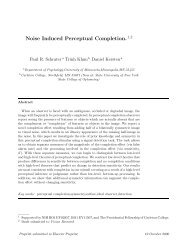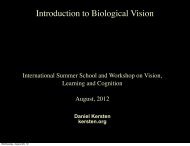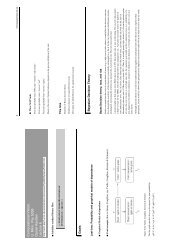Introduction to Neural Networks U. Minn. Psy 5038 Daniel Kersten
Introduction to Neural Networks U. Minn. Psy 5038 Daniel Kersten
Introduction to Neural Networks U. Minn. Psy 5038 Daniel Kersten
Create successful ePaper yourself
Turn your PDF publications into a flip-book with our unique Google optimized e-Paper software.
Lect_6_Matrices.nb 3In[3]:= Array@w, 83, 4
Lect_6_Matrices.nb 5In[16]:= B.AOut[16]= Jax+ cy bx+ dyau+ cv bu+ dv NLaws of commutation, association and distributionIn particular, look at the element in the upper left of the matrix BA above--there is no reason, in general, for ax+bu <strong>to</strong> equalax + cy. That is, matrix multiplication does not commute.Apart from commutation for matrix multiplication, the usual laws of commutation, association, and distribution that hold forscalars hold for matrices. Matrix addition and subtraction do commute. Matrix multiplication is associative, so (AB)C =A(BC). The distributive law works <strong>to</strong>o:A(B+C) = AB + ACNon-square matricesIt is not necessary for A and B <strong>to</strong> be square matrices (i.e. have the same number of rows as columns) <strong>to</strong> multiply them. Butif A is an mxn matrix, then B has <strong>to</strong> be an nxp matrix in order for AB <strong>to</strong> make sense. For example, here F is a 3x2 matrix,and G is a 2x4 matrix.In[17]:= F = {{a,b},{c,d},{e,f}}G = {{p,q,r,s},{t,u,v,w}}Out[17]=ijka bc de fyz{Out[18]= J p q r st u v w NCheck the dimensions with6 Lect_6_Matrices.nbIn[19]:= Dimensions[F]Dimensions[G]Out[19]= 83, 2
Lect_6_Matrices.nb 7In[23]:= IdentityMatrix[2]Out[23]= J 1 00 1 NIt is easy <strong>to</strong> show that the identity matrix plays the role for matrix arithmetic that the scalar 1 plays for scalar arithmetic.How can one divide one matrix, say B, by another, say A? We can divide numbers, x by y, by multiplying x times theinverse of y, i.e. 1/y. So <strong>to</strong> do the equivalent of dividing B by A, we need <strong>to</strong> find a matrix Q such that when A is multipliedby Q, we get the matrix equivalent of unity, i.e. the identity matrix. Then "B/A" can be achieved by calculating the matrixproduct: B.Q.In[24]:= A = {{a,b},{c,d}};Mathematica provides a built-in function <strong>to</strong> compute matrix inverses:In[25]:= Q = Inverse[A]Out[25]=ijkdÅÅÅÅÅÅÅÅÅÅÅÅÅÅad-bc- ÅÅÅÅÅÅÅÅÅÅÅÅÅÅÅcad-bc- ÅÅÅÅÅÅÅÅÅÅÅÅÅÅÅbad-bcaÅÅÅÅÅÅÅÅÅÅÅÅÅÅad-bcyz{We can test <strong>to</strong> see whether the product of a A and Q is the identity matrix, but Mathematica won't go through the work ofsimplifying the algebra in this case, unless we specifically ask it <strong>to</strong>.In[26]:= Q.AOut[26]=ijkadÅÅÅÅÅÅÅÅÅÅÅÅÅÅÅÅÅÅÅÅÅÅÅÅÅÅÅÅÅad-bcad-bc - bc00yadÅÅÅÅÅÅÅÅÅÅÅÅÅÅÅ ÅÅÅÅÅÅÅÅÅÅÅÅÅÅbc ad-bc ad-bc z{In[27]:= Simplify[Q.A]Out[27]= J 1 00 1 N8 Lect_6_Matrices.nbHere is a simple numerical example. Verify that R is the inverse of B by seeing whether the product is theIdentity matrix.In[28]:= B = {{1,-1},{3,2}};R = Inverse[B]Out[29]=ijk2ÅÅÅÅ1ÅÅÅÅ y 5 55- ÅÅÅÅ3 1ÅÅÅÅ5z{Singular and badly conditioned matricesWhat if one row is a scaled version of another row?In[30]:= B1 = {{1.5,1},{3,2.0}}Out[30]=ij 1.5 1 yzk 3 2. {Then the rows of the matrix are not linearly independent. In this case, the inverse is not defined.Ask for the inverse of B1In[31]:= Inverse[B1]Inverse::sing : Matrix i 1.5 1. yj z is singular.k 3.2. {Out[31]=ij 1.5 1 -1yzk 3 2. {Sometimes the rows are almost, but not quite, linearly dependent (because the elements are represented as approximatefloating point approximations <strong>to</strong> the actual values). Mathematica may warn you that the matrix is badly conditioned.Mathematica may try <strong>to</strong> find a solution <strong>to</strong> the inverse , but you should be suspicious of the solution. In general, one has <strong>to</strong>be careful of badly conditioned matrices.Let's try finding the inverse of the following matrix:
Lect_6_Matrices.nb 9In[32]:= B2 = {{-2,-1},{4.00000000000001,2.0}};Inverse[B2]Inverse::luc :-2. -1.Result for Inverse of badly conditioned matrix J Ṇ may contain significant numerical errors.4.2Out[33]=i 2.04709 µ 10 14 1.02355 µ 10 14 yjzk -4.09418 µ 10 14 -2.04709 µ 10 14 {Were we lucky or not?In[34]:= B2.Inverse@B2DInverse::luc :-2. -1.Result for Inverse of badly conditioned matrix J Ṇ may contain significant numerical errors.4.2Out[34]= J 1.0.0.1 ṆDeterminant of a matrixThere is a scalar function of a matrix called the determinant. If a matrix has an inverse, then its determinant is non-zero.Does B2 have an inverse?In[35]:= Det[B2]Out[35]= 9.76996 µ 10 -15Why do we get a zero determinant for B1, but not for B2?In[36]:= Det[B1]Out[36]= 0.10 Lect_6_Matrices.nbMatrix transposeWe will use the transpose operation quite a bit in this course. It interchanges the rows and columns of a matrix:In[37]:= Y = Table@y i,j , 8i, 1, 3
Lect_6_Matrices.nb 11In[40]:= Y[[2]]Out[40]= 8y2,1, y2,2, y2,3, y2,4
Lect_6_Matrices.nb 13Eigenvec<strong>to</strong>rs and eigenvaluesBasic ideaEigenvalues and eigenvec<strong>to</strong>rs crop up in many ways. For example, the solution <strong>to</strong> a set of linear first-order (i.e. no derivativeorders bigger than 1) differential equations can be found in terms of eigenvalues and eigenvec<strong>to</strong>rs. For a simplifiedversion of the limulus equationsdfÅÅÅÅÅÅÅdt = A.f(2)the solution is determined by the eigenvalues and eigenvec<strong>to</strong>rs of A and the initial conditions.Eigenvec<strong>to</strong>rs also crop up in statistics. Principal components analysis is used in dimensionality reduction--also important inneural networks and "natural computation".So what are eigenvalues, eigenvec<strong>to</strong>rs?An eigenvec<strong>to</strong>r, x, of a matrix, A, is vec<strong>to</strong>r that when you multiply it by A, you getan output vec<strong>to</strong>r that points in the same (or opposite, depending on the sign of l) direction as x:Ax = λxwhere λ is an eigenvalue--a scalar that adjusts the length change of x. The eigenvalues are found by solving:Det[A-lId]==0, for lwhere Id is the identity matrix.Let's find the eigenvalues of:In[47]:= A = {{1,2},{3,4}};In[48]:= Id = IdentityMatrix@2DOut[48]= J 1 00 1 NIn[49]:= Solve@Det@A -l*IdD ã 0, lDOut[49]= 99l Ø ÅÅÅÅÅ1 è!!!!!!I5 -2 33 M=, 9l Ø ÅÅÅÅÅ1 è!!!!!!I5 + 33 M==2Now pick one of the solutions for l, find the vec<strong>to</strong>r x={x 1 ,x 2 } that satisfies the basic definition, A.x=lx14 Lect_6_Matrices.nbIn[50]:= SolveA9A.8x 1 ,x2 < == ÅÅÅÅ1 è!!!!!!I5 - 33 M * 881, 0
Lect_6_Matrices.nb 15In[53]:= Sqrt[-1]Sqrt[-1]//OutputFormOut[53]= ÂOut[54]//OutputForm=IIn[55]:= B = {{1,2},{-3,4}};Eigenvalues[B]Out[56]= 9 ÅÅÅÅÅ11I5 -Âè!!!!!! 15 M, ÅÅÅÅÅ I5 +Âè!!!!!! 15 M=2 2‡ Eigenvec<strong>to</strong>rs[ ]The built-in Mathematica function Eigenvec<strong>to</strong>rs[A] returns the eigenvec<strong>to</strong>rs of matrix A as the rows of a matrix, lets calleig:In[57]:= eig = Eigenvec<strong>to</strong>rs[A]Out[57]=1i ÅÅÅÅ 6I-3 - è!!!!!! 33 M 1 yj 1k ÅÅÅÅ 6I-3 + è!!!!!! 33 M 1 z{Verify that eig[[1]] and A.eig[[1]] lie along the line (i.e. in the same or opposite directions) by taking thedot product of the unit vec<strong>to</strong>rs pointing in the directions of each. Use this function:In[58]:= normalize[x_] := x/Sqrt[x.x];16 Lect_6_Matrices.nbPreview of eigenvec<strong>to</strong>rs and dimensionality reductionA measure of the structure of an ensemble of signals (e.g. of vec<strong>to</strong>rs) is the degree of correlation between their elements.Signals, such as sounds and visual images, have correlational structure that is taken advantage of in sound and imagecompression algorithms. One simple kind of statistical structure is characterized by the degree <strong>to</strong> which one can predict oneelement of a vec<strong>to</strong>r from a nearby element. For images, the color of a pixel at location i is a pretty good predic<strong>to</strong>r of thecolor at location j = i+1. As j gets far from i, however, the prediction gets worse. It is possible <strong>to</strong> characterize the degree ofpredictability by a matrix whose ij th element is big if the i th pixel of an image is a good predic<strong>to</strong>r of the j th . One measure ofpredictability is the au<strong>to</strong>correlation matrix. An au<strong>to</strong>correlation matrix has real elements and is symmetric. The eigenvec<strong>to</strong>rsof of the matrix capture the subspace with most of the variance, i.e. where the "action" is. The eigenvalues correspond <strong>to</strong> theamount of "action"--i.e. the variance in the eigenvec<strong>to</strong>r directions.Verify that the eigenvec<strong>to</strong>rs of the symmetric matrix above (H) are orthogonal.Next timeLinear systems analysis & introduction <strong>to</strong> learning/memoryIn the next lecture, we'll apply what we've learned about matrices and vec<strong>to</strong>rs <strong>to</strong> two problems. We'll first take an in-depthlook at the properties of the linear neural network <strong>to</strong> see how it relates <strong>to</strong> general linear systems. We'll also show the advantagesof using the eigenvec<strong>to</strong>rs of the linear transformation matrix as a useful coordinate system <strong>to</strong> represent input andoutput pattern vec<strong>to</strong>rs.We will introduce the <strong>to</strong>pic of learning and memory, and see how the outer product rule can be used <strong>to</strong> model associativelearning.
Lect_6_Matrices.nb 17Preview of linear systems analysisLinear systems are an important, and tractable class of input/output models. Matrix operations on vec<strong>to</strong>rs provide thepro<strong>to</strong>type linear system.Consider the generic 2-layer network. It consists of a weighted average of the inputs (stage 1), followed by a point-nonlinearity(the squash function of stage 2), and added noise (stage 3). Although later we will see how the non-linearity enablescomputations that are not possible without it, useful functions can be realized with just the linear or stage 1 part of thenetwork. We've seen one application already with the model of the limulus eye. In the next lecture, we will see how linearnetworks can be used <strong>to</strong> model associative memory. But first, let us take what we've learned so far about modeling linearnetworks and look at in the general context of linear systems theory. Our 2-layer net is a matrix of weights that operates ona vec<strong>to</strong>r of input activities ty computing a weighted sum. One property of such a system is that it satisfies the fundamentaldefinition of a "linear system", which we will define shortly.The world of input/output systems can be divided up in<strong>to</strong> linear and non-linear systems. Linear systems are nice because themathematics that describes them is not only well-known, but also has a mature elegance. On the other hand, it is a fairstatement <strong>to</strong> say that most real-world systems are not linear, and thus hard <strong>to</strong> analyze...but fascinating if for that reasonalone. Scientists were lucky with the limulus eye. That nature is usually non-linear doesn't mean one shouldn't familiarizeoneself with the basics of linear system theory. Many times non-linear systems can be approximated by a linear one oversome restricted range of parameter values.So what is a "linear system"?The notion of a "linear system" is a generalization of the input/output properties of a straight line passing through zero. Thematrix equation W.x == y is a linear system. This means that if W is a matrix, x1 and x2 are vec<strong>to</strong>rs, and a and b are scalars:W.(a x1 + b x2) = a W.x1 + b W.x2This is a consequence of the laws of matrix algebra.The idea of a linear system has been generalized beyond matrix algebra.Imagine we have a box that takes inputs such as f, and outputs g = T[f].The abstract definition of a linear system is that it satsifies:T[a f + b g] = a T[f] + b T[g]where T is the transformation that takes the sum of scaled inputs f, g (which can be functions or vec<strong>to</strong>rs) <strong>to</strong> the sum of thescaled transformation of f and g. The property, that the output of a sum is the sum of the outputs, is sometimes known as thesuperposition principle for linear systems. The fact that linear systems show superposition is good for doing theory, but aswe will see later, it limits the kind of computations that can be done with linear systems, and thus with linear neural networkmodels.18 Lect_6_Matrices.nbReferencesLinear Algebra and Its Applications by Gilbert Strang, 3rd Edition , Hardcover, 505 pages, Published by Hbj College & School Div. Publication date: February1988© 1998, 2001 <strong>Daniel</strong> <strong>Kersten</strong>, Computational Vision Lab, Department of <strong>Psy</strong>chology, University of <strong>Minn</strong>esota.










